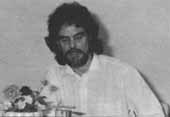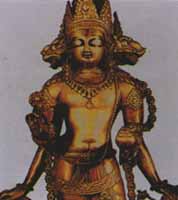The Cosmic Manifestation of Vaikuntha and Visvarupa”
Prof. Thomas Stuart Maxwell of University of Bonn delivered a captivating lecture on `Vaikuntha and Visvarupa’ of Visnu. The talk revolved around the cosmic concept of superimposed multiheaded sculptures which manifested as a movement of worship and took a definite route geographically only to bring about a cosmic harmony
Prof. Maxwell traced that during the Kushana period one can notice a two-dimensional sculpture of Vasudeva coming out of Balarama’s shoulder alongside other motifs. At the back of this sculpture a tree is noticed. Tree, since hoary past, remained a subject of theological metaphor which sheltered all the cosmic contemplations of Man! Prof. Maxwell cited another example from Kushana period where six female figures are branching out from one another in a singularistic aesthetic form. These images are similar to the tree motif behind the sculptures which has branching dimension from the trunk! These six female figures are embodiment of Sakti with six gunas. The creative force has been depicted in a manifestive from vis-à-vis the tree. Analysing the sculptures Prof. Maxwell opined that in the Kushana period the sculptures are sperim-posed and give a dimensional perspective to depict as if one body is coming out from another. However, in the later period we find only faces and not part of the body coming out from one another. The sculptural remains of Gupta period in 5th century AD testify this fact. The Mathura sculptures of this period clearly show that there are mainly two types of Visnu images. However, both the Visnu images give three-headed inwardly projections, consisting of a crowned deity in human form with the heads of Varaha and Narasimha – the Visnu reincarnations, emerging out from the junction between neck and shoulder on either side. In the other type one can see the three-headed Visnu with a nimbus behind studded with numerous miniature figures as described in Bhagavadgita. This cosmic dimension of Visnu is known in Gita as Visvarupa.
In the post-Gupta period, Prof. Maxwell said, the concept of Visvarupa travelled southward from Mathura along the Dwarka trade-route to Samalji in northern Gujarat. Simultaneously, the Visvarupa travelled northward into the small mountain-valley kingdoms of western Himalaya from the sutlej to the Swat valley. It even travelled up to Kabul. In Central Asia the nimbus of Buddha filled with varied motifs are also indicative of dimensional manifestation of this concept.
In the 8th century, history of India has witnessed the concentration of the two Visnu images in the hands of two separate power groups; the Visvarupa image was developed and patonised by the Gurjara-Pratiharas as they moved northward from Malwa to the Ganga-Yamuna plain, while in the northwest the three-headed Visnu was taken up especially in the Jhelum valley of Kashmir by the later Karokota kings and their successors. This polarisation took a dramatic turn in the 9th century, when the Gurjara-Pratiharas conquered the city of the Kanyakubja (Kannauj) and the Utpala dynasty arose in Kashmir. Gurjar’s developed this iconography of Visvarupa and enshrined at least two major images in Kannauj itself. On the other hand, Yuvaraja Avantivarman of the Utpalas took up the old icon of three headed Vishnu and added a fourth face to it. This cautranana-Visnu concept originated from Pancaratrins, whose devotional name was Vaikuntha and installed in a new temple at Avantipura.
This Vaikuntharupa of Visnu consists of crowned human face alongside Varaha and Narasimha. At the back of this image a face is seen which is generally named Kapilamuni with tripundra tilak with flat nose resembling Bhairava iconographical perspective. It is interesting to note that the faces of Varaha and Narasimha are depicted outward to create a clear angular dimension and are unlike the inward or on-looking forty five degree faces of Gupta period. Prof. Maxwell observed that the face of Varaha is as ferocious as Narasimha, which was also indicated by Dr. P. Pal and Dr. B.L. Malla in their earlier works. He traced a Kashmiri legend where it is described that Visnu took the Varaha is depicted in a ferocious manner, observed Prof. Maxwell.
The theological of Vaikuntha has evolved out of mental contemplations. Towards this image of Vaikuntha iconography there are three stages, explained Prof. Maxwell. Those are Bija Mantra, 18 syllabled Murti Mantra and Dhyana Mantra. With separate invocations a devotee is able to realise the wholesome concept of Vaikuntha. The cult of Vaikuntha spread from Ganga-Jamuna plain to present Bangladesh. However, in the 10th century Vaikuntharupa became in vogue amongst Rajputs and found nurtured as a symbol of independence. The evidence of Vaikuntha and Visvarupa concepts got a different perspective when number of arms were added which still remains in vogue. The evidence of Vaikuntha is found in Rohtak etc. which travelled upto Gujarat. In Gujarat we find that caturanana Vishnu and three-headed Visvarupa are worshipped side by side.
Thus from the days of Kushana to the present day the concept of multi-headed Visnu manifested within a region and this pantheism patronised by the then rulers later took different trade routes and finally submerged into a cosmic pan-Indian unity.
Summing up the theme Shri M.C. Joshi said, for a Hindu devout the form and shape do not really hinder his spiritual aspirations and he could find unity of single theme manifested from salagram, linga or multi-headed Visnu which are indicative of a cosmic reunion of one and all formed or formless.
Vihangama Correspondent
[ Newsletter | List of Newsletter ]






